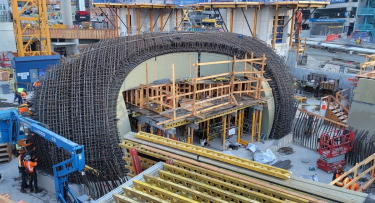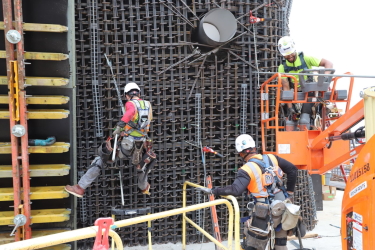|
Subscribe / Renew |
|
|
Contact Us |
|
| ► Subscribe to our Free Weekly Newsletter | |
| home | Welcome, sign in or click here to subscribe. | login |
Construction
| |

January 5, 2023
Years of planning leads to historic pour for the Seattle Aquarium Ocean Pavilion
Special to the Journal
Brute force and advanced software are working in concert on Seattle's waterfront to form a massive arena for marine life.
Turner Construction recently completed a 24-hour concrete pour that was the culmination of years of planning, to mimic an organic-shaped bowl that will be the centerpiece of the new Seattle Aquarium Ocean Pavilion.
Turner's virtual design and construction department used advanced 3D software, such as Rhino, Tekla and Navisworks, which played an important role in design coordination and construction planning, according to William Ketcham, vice president and general manager at Turner.
“Due to the complexity of the main tank's curved geometry and varying thicknesses, the project architect, LMN, provided the model for the main tank and the archipelago tank as a document in Rhino 3D,” Ketcham said. “Without this model, we would not have been able to generate reinforcing formwork that aligned with what the design team intended.”
The intricate mesh of rebar needed to help create the form for the aquarium's main tank was made possible by 3D software, according to Ketcham.
The virtual design and construction department used Rhino and Grasshopper programs to generate rebar geometry for the formwork that aligned with the architect's model. This model, which was converted into 2D shop drawings, was used to detect clashes within the rebar to determine whether the typical and added reinforcing detailed in the structural drawings was constructible.
Modeling efforts from contractors Peri Formwork Systems, formwork provider, and Janicki Industries, foam fabricators, were crucial to the formwork design, according to Ketcham. The virtual design and construction department team coordinated within Navisworks' software model to determine constructability concerns prior to fabrication of the formwork.
This main tank is designed to hold 385,000 gallons of salt water and rises 30 feet from the foundation. Turner used roughly 700 cubic yards of concrete.
“This pour was the culminating result of years of planning — from preconstruction all the way to concrete placement and stripping,” Ketcham said. “Superintendents, laborers, carpenters, finishers and engineers from other Turner projects in the Seattle area came to help support the SAOP project team in completing this milestone pour.”
Turner worked with Stoneway Concrete and structural engineers at Magnusson Klemencic Associates to develop a strength of 10,000 pounds per square inch, using a self-consolidating concrete mix without aggregate. Ketcham said Turner partnered with a professor at the University of Illinois at Urbana-Champaign to conduct research on pour pressure of self-consolidating concrete in both standard concrete compared to the designed curved formwork of the aquarium. It was determined that the pressures can be controlled by lowering the filling rate.
“Not only was the self-consolidating concrete mix ideal for placing to a high wall height in congested reinforcing, it was also denser than typical concrete, essentially acting as an additional barrier to chloride diffusion,” said Ketcham. “This eliminated the requirement for epoxy reinforcement.”
The site itself has presented challenges for Turner, with Hoffman Construction working on the Overlook Walk that connects Pike Place to the roof level of the aquarium project and Gary Merlino Construction working on the rerouting of Alaskan Way to the east of the SAOP jobsite.
“The SAOP jobsite has a small footprint, which means there is little area for staging of formwork and materials,” he said. “The main tank formwork consists of 280 panels and foam pieces, all of which went through multiple subcontractors. Tracking each panel's current location and ensuring they were fabricated in time for setting dates was challenging. Most panels were stored at SeaTac Marine yard and available for will-call pickup.”
The nearby Alaskan Way roadway shift required installation of a protection system to ensure safety of the public during work on the main tank. Other projects along the waterfront affected pedestrian routing from the waterfront to the Pike Place Market area, which affected Turner's loading logistics plans, according to Ketcham. Larger concrete placements, such as the foundation and the main tank, were completed on Saturdays to minimize impacts on rush hour, and starting earlier in the day to avoid the tourist rush later in the day.
Ketcham said Turner has extensive experience with large-scale aquarium work.
“Aquariums are important and unique facilities that require specialized systems, features and building assemblies that are not common in conventional building construction,” he said. “These specialized systems require specific knowledge and installation experience to effectively plan and construct a quality aquarium facility.”
Previous columns:
- Analysts see continued slowdown for homebuilders, 12-15-2022
- World Cup stadium — built with 974 recycled shipping containers — was designed to disappear, 12-08-2022
- The new holy grail for general contractors: nailing down lead times for key components, 12-01-2022
- Outlook 2023: Today’s industry trends will impact next year’s property insurance rates, 11-17-2022
- Lawyer says legal issues may loom on the horizon for pandemic-era buildings, 11-10-2022
- Washington Supreme Court ruling could bring changes to the construction industry, 11-03-2022
- Southeast Portland building blends a rich palette of art deco with fine wines, 10-27-2022
- How construction firms can deter theft of equipment, supplies, 10-20-2022




